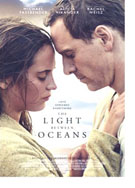

Opening 8 Sep 2016
Directed by:
Derek Cianfrance
Writing credits:
Derek Cianfrance, M.L. Stedman
Principal actors:
Michael Fassbender, Alicia Vikander, Rachel Weisz, Florence Clery, Jack Thompson
In 1918 Tom Sherbourne (Fassbender) returns to Australia after horrifying experiences as a soldier in the First World War. The idea of working all alone in an isolated lighthouse on an island appeals to his sense of survival and slow recovery from war trauma. He sets off by boat, but not before making the acquaintance of Isabel (Vilander), who is smitten with him. They correspond over many months and meet during his rare visits on the mainland. She has no qualms to marry him and move to the lighthouse. Their placid lives roll peacefully with the rising and setting sun over the ocean. Then tragedy strikes and Isabel suffers two miscarriages and buries two unborn babies. It’s not until five years later and the film is half over, that Tom discovers a rowboat off shore containing a male corpse, and a baby, still alive. Surely fate has chosen Tom and Isabel to be the new parents. The rest of the film swings between euphoria and guilt. Tom recognizes the real mother, Hannah (Weisz), in their village. Hannah recognizes her child, who is no longer a baby, but a delightful young girl. We learn that the real father, the corpse in the boat, was a German immigrant, who was rejected by Hannah’s millionaire father, Septimus Potts (Bryan Brown).
The film is billed as a tear jerker; perhaps it is. It seems to go on forever with longing gazes, desperate hugging, averted glances, and declarations of love all around. During viewing, I kept mentally rewriting the script, in order to end this agony quickly; the music adds to the desperation of the urge to end things. Worthwhile is the lighthouse, which is almost a character in its own right. It is the Cape Campbell Lighthouse built in 1870 in Cook Straight off the coast of New Zeeland.
The film is based on a bestseller of the same title by M.L. Stedman, which came out in 2012, although Cianfrance changed some of the plot. For example, in the book both Tom and Isabel know their child’s birth mother; in the film it is only Tom who must suffer this guilt alone. Naturally, the actors are fine, especially Alicia Vilander, whom we know from a former film: The Danish Girl. (Becky Tan)